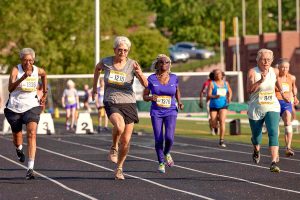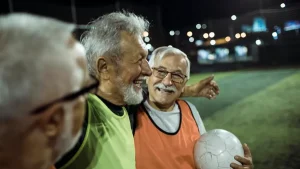6
Section One: The Fundamentals
A) Keywords
Exercise 1:
Provide a brief definition of one of the padlet keywords for this week.
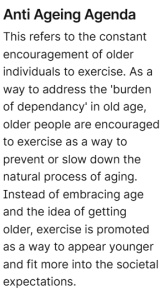 This example was done by me* This example was done by me* |
B) The Social Significance of Aging in Sport
Exercise 2: Notebook Prompt
How is old age popularly represented today? Find an image online that you think exemplifies one defining attitude towards old age and paste in your notebook below with a brief explanation of what this image means to you.
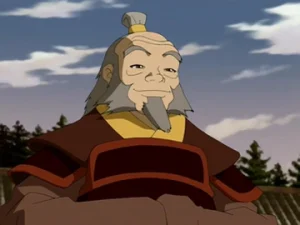
Old age is more popularly represented today in entertainment and social media in the content we consume. When talking about television roles, older characters are seen as wise, passing on wisdom to younger generations. Or, they can be seen as grumpy comic relief type characters. Examples being Uncle Iroh acting as a mentor for Zuko in the Avatar The Last Airbender series[as seen above] or Red Forman from That 70’s Show. |
Exercise 3: Notebook Prompt
What does the article (referencing another study by Dionigi) mean by its statement that sport can help aging people to simultaneously “accept and resist the ageing process” (572)? Respond by audio or text and find paste two images sourced online into your notebook showing how sport might help aging people to both accept and resist the aging process.
| This statement means that sports have two roles when it comes to the ageing process. It can help older people embrace ageing in a way that they have control over. A part of the ageing process includes not having control over the different ailments you may experience. Sport can help gain that control back by being a positive outlet. The empowerment and control over the situation, or sport, helps to accept their realities.
Sport can also be used to resist the ageing process by encouraging exercise towards older people. Pike mentions the ‘anti ageing process’ which encourages exercise as a way to counter the dependency experienced in older age. Elderly individuals use sport as a way to push themselves and improve performance, including mobility and overall positive impacts to health.
|
Exercise 4: Notebook Prompt
Who are the groups less likely to have extensive opportunities to take part in sports, according to Pike? How does privilege factor into aging and sport? (200 words max)
|
According to Pike’s article, groups who are less likely to have extensive opportunities include those who are disabled, those who are frail, minority groups, those who are confined to care facilities and those who live in rural areas.
An example of how privilege factors into aging is those who are apart of lower income families or marginalized groups won’t have the same access to certain spaces compared to those who have more privilege. It might be harder to afford and consistently have gym memberships and living in areas that have safe and affordable facilities as an example. As they age, they might not have the same opportunities to stay physically active.
|
Exercise 5: Padlet Discussion
Why do you think age discrimination is “reported more than any form of prejudice” with older people presented as a threat to social values and interests? Feel welcome to use video in your responses. Paste your comments (or transcript of your video) below!
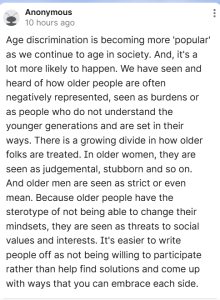 This example was done by me* This example was done by me*
|
B) Older Women and Sport
Exercise 6: Notebook Prompt
What differences do you see in these ads? Which one is more inclusive? How is age represented or not represented in each? Answer these questions in your notebook.
| The main difference I see is the ad titled “This Girl can” includes women of all ages participating in things that keep them active, Whether it be swimming, climbing, general exercise and so on. It’s main focus seems to be encouraging women to have autonomy of their bodies and do things that bring them joy rather than wait on what society or other people might think. The second ad titled “You can’t stop us” shows more sports, showing that no matter who you are [woman, man, disabled and everyone in between] you are capable of whatever you put your mind to. In my opinion, age is more presented in the first ad based on the fact that it shows women of all ages participating. Age really isn’t the main point of the second add.
|
Exercise 7: Notebook Prompt
In her article, “Assessing the sociology of sport: On age and ability,” Elizabeth Pike references a “trend towards a ‘feminisation of ageing’, with many women living longer than men” (573). Do you agree that aging has been “feminized” in this way? How? Answer these questions in your notebook.
| Based on extremely personal experience I do agree that women tend to live longer than men. When my father was sick, to the point he might not have made it, it took so much convinving to even get him to go the doctor’s. It was really frustrating because it’s a pattern. I’ve seen this pattern multiple times in people close to my family that have died. My mother on the other hand will run to the doctor’s for even a slight ache just because she wants to stay ahead of everything.
Of course this is just a personal example but if you look up statistics certain studies do seem to show that the life expectancy for women is higher than their counterparts. This can be due to a multitude of reasons. Women tend to have more pressure in society to take care of themselves and others, more unrealistic standards are placed on women and so on. So yes, I do agree with Pike.
|
Section Three: Module Mini Assignment
|
|

